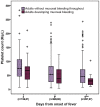Clinical features of dengue in a large Vietnamese cohort: intrinsically lower platelet counts and greater risk for bleeding in adults than children
- PMID: 22745839
- PMCID: PMC3383761
- DOI: 10.1371/journal.pntd.0001679
Clinical features of dengue in a large Vietnamese cohort: intrinsically lower platelet counts and greater risk for bleeding in adults than children
Abstract
Background: As dengue spreads to new geographical regions and the force of infection changes in existing endemic areas, a greater breadth of clinical presentations is being recognised. Clinical experience suggests that adults manifest a pattern of complications different from those observed in children, but few reports have described the age-related spectrum of disease in contemporaneous groups of patients recruited at the same geographical location.
Methodology/principal findings: Using detailed prospectively collected information from ongoing studies that encompass the full spectrum of hospitalised dengue cases admitted to a single hospital in southern Vietnam, we compared clinical and laboratory features, management, and outcome for 647 adults and 881 children with confirmed dengue. Signs of vascular leakage and shock were more frequent and more severe in children than adults, while bleeding manifestations and organ involvement were more common in adults. Additionally, adults experienced significantly more severe thrombocytopenia. Secondary infection but not serotype was independently associated with greater thrombocytopenia, although with a smaller effect than age-group. The effect of age-group on platelet count was also apparent in the values obtained several weeks after recovery, indicating that healthy adults have intrinsically lower counts compared to children.
Conclusions/significance: There are clear distinctions between adults and children in the pattern of complications seen in association with dengue infection, and these depend partly on intrinsic age-dependent physiological differences. Knowledge of such differences is important to inform research on disease pathogenesis, as well as to encourage development of management guidelines that are appropriate to the age-groups at risk.
Conflict of interest statement
The authors have declared that no competing interests exist.
Figures




References
-
- World Health Organization. Dengue: Guideline for diagnosis, treatment, prevention and control. 2009. WHO, Geneva, Switzerland. - PubMed
-
- Wichmann O, Hongsiriwon S, Bowonwatanuwong C, Chotivanich K, Sukthana Y, et al. Risk factors and clinical features associated with severe dengue infection in adults and children during the 2001 epidemic in Chonburi, Thailand. Trop Med Int Health. 2004;9:1022–1029. - PubMed
-
- Kittigul L, Pitakarnjanakul P, Sujirarat D, Siripanichgon K. The differences of clinical manifestations and laboratory findings in children and adults with dengue virus infection. J Clin Virol. 2007;39:76–81. - PubMed
Publication types
MeSH terms
Grants and funding
LinkOut - more resources
Full Text Sources
Other Literature Sources
Medical
Research Materials

